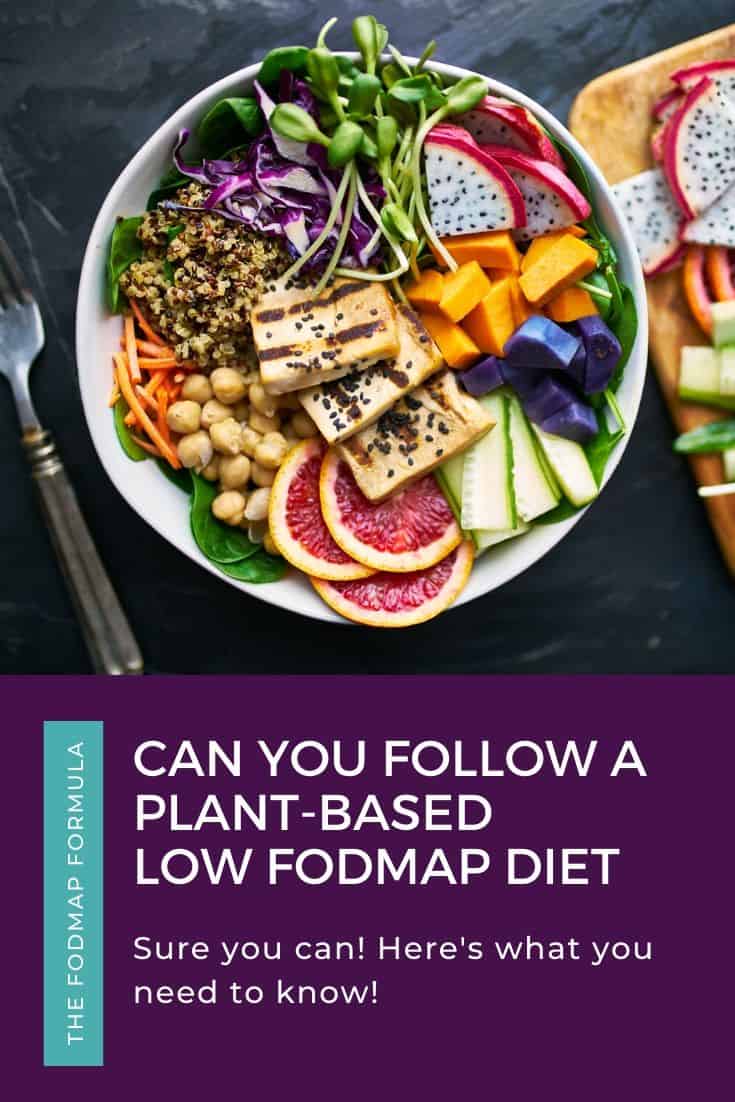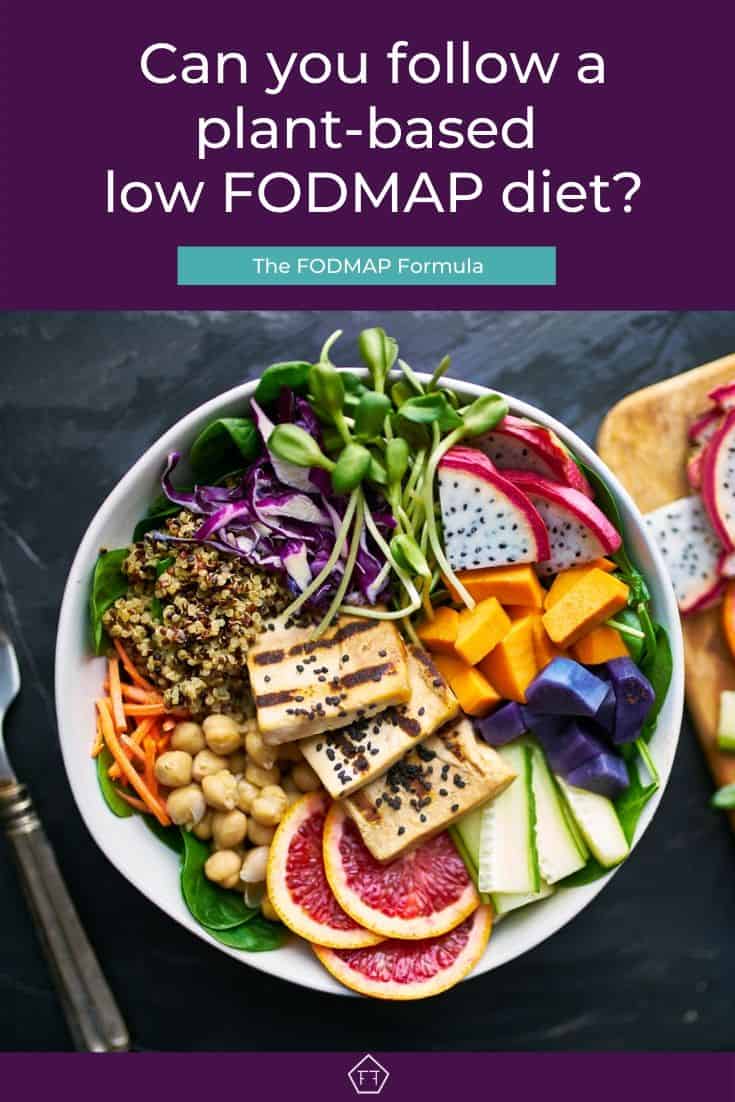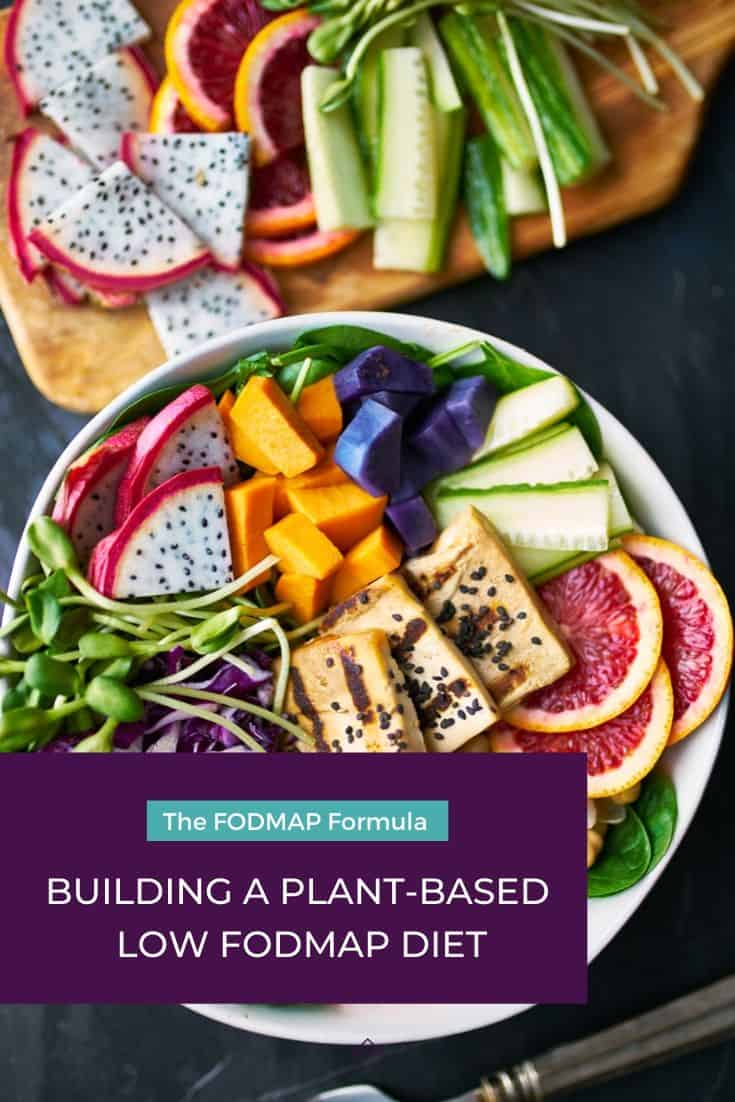Wondering if you can combine a plant-based diet with the low FODMAP diet? Though following a vegetarian or vegan diet does make the low FODMAP program a little more complicated, it can certainly be done! Check out the article below to find out more about maintaining a well-balanced plant-based low FODMAP diet!
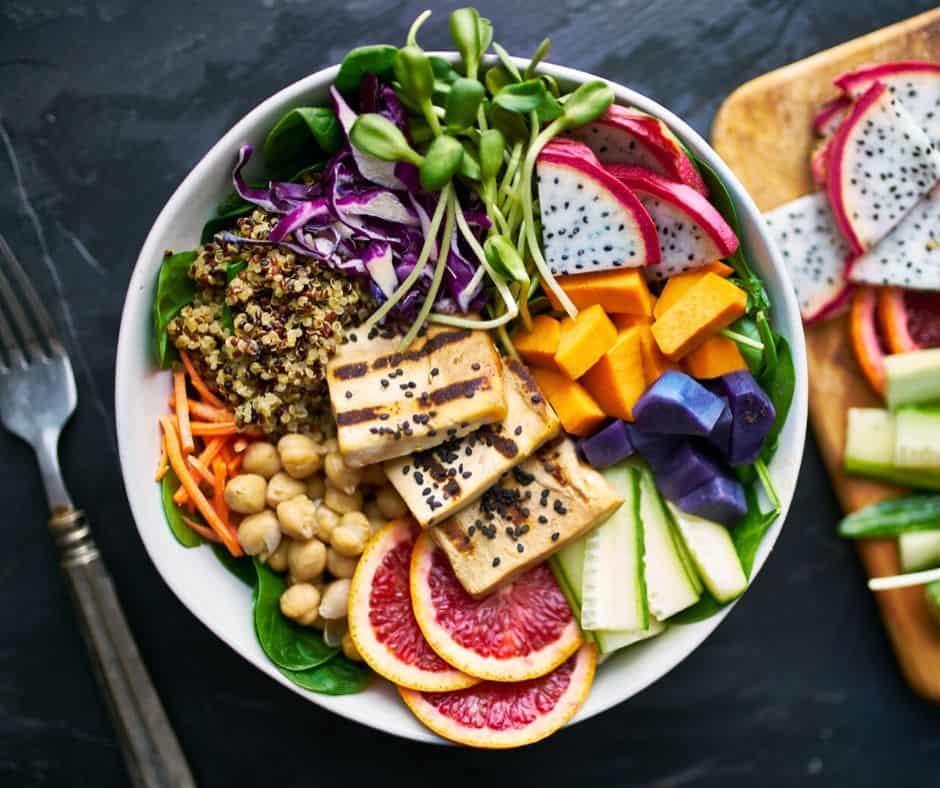
Can I follow a plant-based low FODMAP diet?
The short answer is yes! You can follow a plant-based low FODMAP diet! But, because many plant-based sources of protein (like beans, nuts, seeds, and some soy products) are high FODMAP, it can get a little tricky!
Because of this, I highly recommend consulting one-on-one with a FODMAP-trained gut specialist before starting any plant-based low FODMAP program.
A FODMAP-trained specialist will help you find high-quality sources of low FODMAP protein and make sure you’re getting enough essential nutrients in your diet to support your age, gender, and current level of physical activity.
What does a “plant-based” diet mean?
First of all, there are a few ways people talk about a “plant-based” or a “plant-focused” diet. Let’s make sure we’re all talking about the same thing before we get started.
Whole food diet
A whole food diet focuses on foods that aren’t heavily processed. This essentially means the focus is on eating foods as close to their natural form as possible. This may include whole fruits and vegetables, whole grains, nuts, seeds, and free-range meats that aren’t treated with antibiotics or hormones and excludes foods with processed sugar or additives.
A whole food diet may or may not also be a plant-based diet.
Plant-based diet
Surprisingly, there is no one definition of a “plant-based diet.” Some people describe it as limiting or avoiding meat products. Others describe it as making sure the majority of their diet is plant-based (though they still eat some meat and seafood or animal byproducts like eggs, honey, and dairy).
A plant-based diet may or may not also be a whole food diet.
Vegetarianism
While hearing someone is vegetarian may feel very straightforward, vegetarianism includes a wide range of dietary styles:
- Flexitarian – A flexitarian focuses on eating a mainly plant-based diet, but they may eat small servings of meat, dairy, and eggs on occasion.
- Lacto-Ovo vegetarian – Excludes meat, poultry, and fish, but still eats dairy products and eggs.
- Ovo vegetarian – Excludes meat, poultry, fish, and dairy, but still eats eggs.
- Pescatarian – Excludes meat, poultry, dairy, and eggs, but still eats seafood.
- Vegetarian – Excludes all meat, poultry, dairy, and eggs, as well as animal byproducts like honey and gelatin
Veganism
Veganism excludes all animal and animal byproducts, including all meat, poultry, dairy, eggs, honey, and gelatin, as well as products related to animal cruelty or exploitation such as silk, leather, wool, or fur, etc.
Veganism itself includes more than just what a person eats and is, instead, a particular lifestyle. People who follow vegan principles consciously choose to live in a way that does not cause harm to animals through the products they purchase, the communities and companies they engage with, and other minute choices in their daily lives.
Because the vegan diet is exceptionally restricted, it’s highly recommended that people who follow a vegan diet seek the help of a FODMAP-trained dietitian during the low FODMAP program.
A dietitian may recommend shortening the elimination phase or completing the re-challenge phase in steps to maintain proper nutritional balance throughout the program.
Can I start a plant-based diet and a low FODMAP diet at the same time?
While starting the low FODMAP program may feel like the perfect opportunity to shake up your food attitude, this is not the time! If you’re pursuing a plant-based or plant-focused diet to improve your overall health, you may want to hit pause until after you’ve completed the low FODMAP program.
For starters, sudden changes in our daily fibre can cause symptoms like bloating, cramping, and diarrhea as our bodies struggle to cope with the added roughage in our system. Switching from a standard western diet to a plant-focused diet would involve a significant change in your in fibre, so you won’t be in for a good time.
More than being a pain in the butt, symptoms caused by dietary changes can overshadow the benefits you should see during the elimination phase of the program. Or may give you the impression that the low FODMAP program has made your symptoms worse.
Plus, trying to lose weight or “eat clean” puts a lot of stress on our bodies and our brains. Following a low FODMAP diet is already a stressful experience for most people. Adding additional restrictions like calorie counting and managing macronutrients may create an overly restrictive diet and stress you right into a flareup.
Monash University, who developed the low FODMAP diet in 2005, stresses the importance of following your current diet as closely as possible during the low FODMAP program.
In fact, the program was designed to help people with IBS swap out high FODMAP ingredients for low FODMAP ingredients in their daily cooking to mirror their regular diets as closely as possible.
So if you’re thinking about transitioning into a plant-based or plant-focused diet, try experimenting with new low FODMAP fruits and vegetables to see what you like during the low FODMAP program and approach any new styles of eating once you have more information about which plant-based foods work for your body.
How do I get enough nutrients while eating a plant-based diet?
Since FODMAPs are found in a wide range of foods, the low FODMAP program is already very restrictive. Adding a second layer to the puzzle, like vegetarianism or veganism, can make following the low FODMAP program a little more complicated. But it can absolutely be done!
If you’re integrating the low FODMAP diet into a plant-based diet, the first thing you should do is consult a FODMAP-trained gut specialist. A trained specialist can take a look at your current diet and help you find safe servings sizes of many vegetarian staples (like beans, nuts, and seeds) and help you find low FODMAP swaps for any high FODMAP foods in your daily diet.
Here is a short overview of some of the nutrients you’ll need to consider during the low FODMAP program.
Protein
The first thing you want to think about is finding low FODMAP sources of protein. Protein plays a vital role in cell growth and repair, so you want to make sure you’re getting enough to support your body.
Since many plant-based proteins like beans, nuts, and some soy products are high FODMAP, it can be challenging to get enough protein in a plant-based low FODMAP diet.
There are, however, lots of options available to you! For example, you can add low FODMAP serving sizes of extra firm tofu and tempeh or canned chickpeas and lentils to your meals. You can also include walnuts, peanuts, and pumpkin seeds in your snacks and shakes, etc.
Remember to check the Monash app for the low FODMAP serving sizes of the foods you eat. You should be especially careful when mixing protein sources to avoid FODMAP stacking.
Iron
Iron plays an essential role in creating and maintaining red blood cells. You can find iron in leafy vegetables like spinach and kale, nuts like Brazil nuts and pine nuts, grains like quinoa and oats, and seeds like sesame seeds or pumpkin seeds.
Fibre
Getting enough fibre on the low FODMAP diet can be tricky! But it’s an essential part of a healthy diet.
Not only does fibre keep your insides moving, but many types of fibre also belong to a particular group of foods called prebiotics.
Prebiotics are like a bag lunch for your good gut bugs. The low FODMAP diet is very low in prebiotics (as they’re often high FODMAP), so you’ll need to include safe servings of fibre whenever you can.
There are two general types of fibre you’ll encounter in your diet. “Soluble fibre” and “non-soluble fibre.”
Soluble fibre – This type of fibre dissolves in the digestive system, creating a gel that helps slow down digestion (helpful for people with diarrhea). This type of fibre is found in certain fruits and vegetables, as well as legumes, oats, psyllium, and flaxseed.
Non-soluble fibre – This type of fibre isn’t digested very well by the gut, so it tends to stay in it’s “natural” form and add bulk to your poop. This can help speed up digestion (if you need help managing constipation). Non-soluble fibre can be found in some fruits and vegetables as well as grains like wheat and bran.
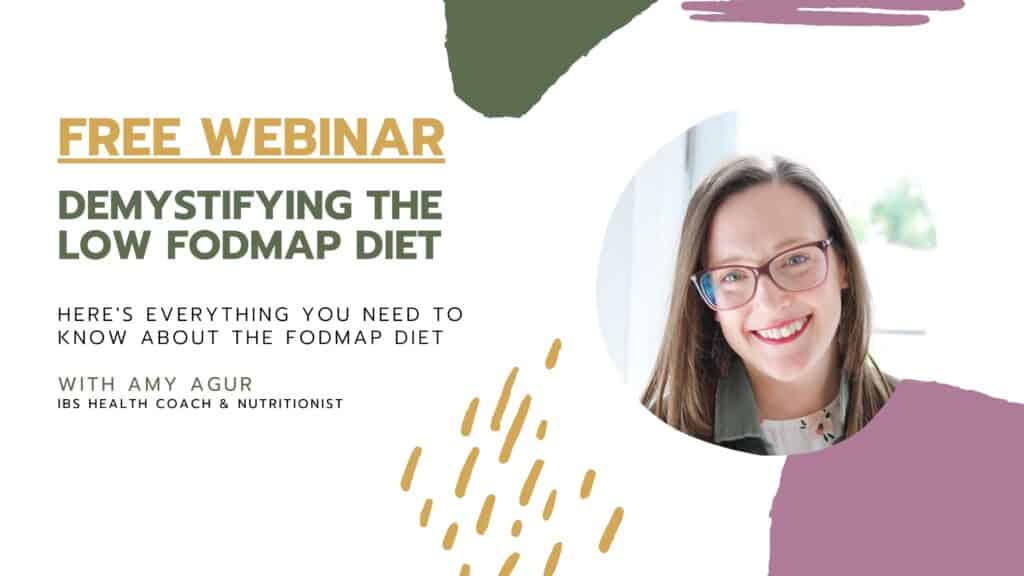
Healthy Fats
Healthy fats play an essential role in the health of our nerves, spinal cord, and brain. So don’t skip out on these!
You can find healthy fats in plant-based oils like olive oil, canola oil, avocado oil, etc. as well as in whole foods like avocado, walnuts, and chia seeds (make sure to check your Monash app for low FODMAP servings).
If you’re following a Lacto-Ovo, Ovo, or flexitarian vegetarian diet, fish and eggs are also a great source of both protein and healthy fats.
Do I need to take supplements to balance my diet?
While there are protein shakes, supplements, and multivitamins available to support your diet, many dietitians and health coaches recommend the best source of essential nutrients is whole foods.
While the low FODMAP diet isn’t forever, a FODMAP-trained specialist can look over your general diet and help you make an informed decision about creating a balanced diet during the elimination and re-challenge phase of the program.
A trained specialist can also help you transition into the re-challenge phase as soon as possible, or break the program into stages to help increase the number of foods you have access to during the elimination and re-challenge phases of the program.
Final Thoughts
While following a plant-based low FODMAP diet can be challenging, it is absolutely possible! By consulting with a FODMAP-trained gut specialist and utilizing low FODMAP serving of proteins and other nutrient-dense foods, there is no reason you can’t create a well-balanced low FODMAP diet!
You might also like one of these:
- Is your gluten intolerance really an insensitivity to fructans Gluten isn’t the only thing in your grains that can turn your tummy! Check out this article to understand the difference between gluten and fructan sensitivity and how to find out which one you’re actually reacting to.
- Is sugar low FODMAP? Have questions about sugar and the low FODMAP diet? Check out this article for everything you need to know about the sweet stuff and your gut!
- How to prepare for the low FODMAP diet Starting the Low FODMAP Diet doesn’t have to be scary! These practical tips will help you get your home and your self ready to rock the Low FODMAP Diet.
If you like this post, don’t forget to share it! Together we’ll get the low FODMAP diet down to a science!
